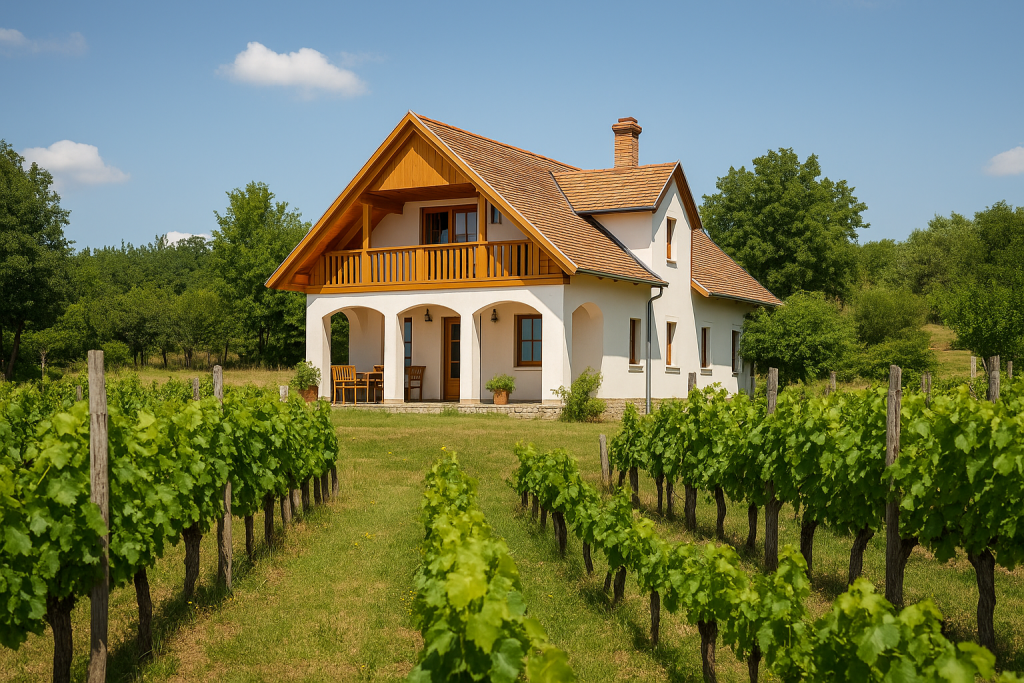It’s May 2nd in Hungary. The shops have reopened, yes—but most offices, schools, and anything resembling formal responsibility are still observing the unspoken ritual of a four-day weekend. Like many others enjoying rural Hungary this time of year, we’ve joined the exodus. Not to the spa hotels or big lake resorts, but to the small plot of land we call our own, somewhere up a winding track in the Balaton Highlands.
Our press house isn’t one of the grand ones with sculpted terraces and a view of Lake Balaton shimmering in the distance. Ours sits humbly among plum trees and wild oregano, surrounded by the quiet clatter of birdlife and the distant hum of a tractor. Built decades ago by hand, brick by brick, it had been used only occasionally over the past ten years when we found it—solid, simple, and full of potential. It has three rooms, a wine cellar, modern plumbing and electricity, and enough quirks to keep things interesting.
A Brief History of Rural Hungary’s Press Houses
What most people don’t realise is that properties like these—scattered across Hungary’s wine regions and countryside—aren’t just cute fixer-uppers. They’re rooted in a very specific history.
During the socialist period, particularly from the 1960s to the 1980s, Hungarians who lived in cramped panel apartments (panellakások) in cities like Budapest or Székesfehérvár would escape to their zártkertek—small agricultural plots just outside town, many of them no larger than a tennis court. These plots weren’t about prestige. They were about survival, peace, and a bit of privacy. A place to grow vegetables, keep bees, or store the family’s homemade wine.
These plots weren’t zoned for residential use. They were categorised as agricultural land, with strict regulations on permanent buildings or habitation. But where there’s a will, there’s a workaround. Press houses—or présházak—evolved as a way to make these rural escapes more functional. A grape press below, a table and bed above. No plumbing, minimal electricity. But freedom.
Many of these press houses became unofficial weekend homes. Owners hauled water, bathed in metal tubs, and some even rigged up early solar systems. To this day, many remain off-grid and self-sufficient.
When we found ours, it still had the original hand press in the cellar and a chimney built from volcanic stone. My husband—who has spent the last two years renovating it—will tell you it also had wiring that could start a fire just by looking at it sideways. But we’ve kept the soul. And the family who built it, who we’re still in contact with, love seeing photos of “Nagypapa’s garden” being restored by a couple of city folk who clearly adore the place.
Understanding the Terminology
Let’s talk semantics for a moment, because you’ll see several terms thrown around when it comes to countryside buildings in rural Hungary. The Hungarian word présház translates directly as “press house”—a building traditionally used for wine pressing and storage. You might also hear people call them borházak (wine houses), especially if they’ve been renovated for more social or residential use. In English, they’re often referred to interchangeably as press houses or winehouses.
While the names vary, they all point back to the same functional roots: a place to work the land, store grapes or barrels, and maybe sleep after a long harvest day. What defines many of them isn’t their form, but their purpose—and the charm they now bring to weekends spent escaping the noise of city life.

A renovated two-storey winehouse in rural Hungary, blending traditional charm with modern comfort—surrounded by vineyards under a clear summer sky.
From Rural Necessity to Modern Refuge
Hungary’s countryside is now a curious blend of old and new. Some press houses have become luxury hideaways, complete with infinity-edge pools, hot tubs, and guest suites. Others still wear their rustic charm proudly—stone walls, creaky shutters, and grapevines growing wherever they please. And then there are some, like ours, that blur the line: rustic on the outside but hiding a few surprises within.
Thanks to my husband’s hard work, ours is now a secure smart home with automated lighting, climate control, and even an outdoor cinema setup for movie nights under the stars.
There’s a certain poetry to sitting under a cherry tree with a glass of fröccs. Forty years ago, someone’s uncle did the same—cycling in from town, hoping the state wouldn’t check the zoning.
Today’s buyers encounter their own challenges. These properties fall under agricultural zoning, so there are no residency rights or address cards unless you initiate a művelési ág (land use category) change. It’s a bureaucratic process that may require inspections, upgrades, and patience. I cover all of that in my ebook.
Still, it’s rewarding. There’s something grounding about learning to live simply. Chop wood for the stove. Barter homegrown tomatoes for blackberry jam. Watch your carefully planted herbs thrive (or die heroically trying).
Rural Hungary, Beyond the Brochure
Weekends like this one highlight how different life feels outside the capital. In the village, your job title doesn’t matter. What matters is whether your dog is friendly and if you remembered to bring your own bag to the shop. A wave as they pass, a nod in the shop, a mushroom delivery when the rain has been good—this is everyday life in rural Hungary. Over time, your winehouse becomes more than just a weekend escape. It turns into a respectful nod to heritage.
We’re lucky to be near places like the Tapolca Mill Pond, Sümeg Castle, and the delightful chaos that is the Káptalantóti Market. But the real beauty of owning a press house in rural Hungary isn’t location. It’s rhythm, a slower gear, and the simple pleasure of watching your husband plaster a wall for the third time because “it still isn’t quite level”—knowing that no one, anywhere, is in a rush.
Thinking About Buying One in Rural Hungary?
Here’s what I’d suggest:
- Visit in every season. These plots can be paradise in spring and impassable in January.
- Speak to the neighbours. They’ll know the history and whether that collapsing shed next door is a treasure trove or a ticking time bomb.
- Understand the current cost of renovations. Press houses often come with “character”… and roof leaks.
And if you’re serious about understanding what it takes—zoning laws, utility hacks, cultural etiquette, mushroom etiquette—I’ve poured everything I’ve learned into HOW TO HUNGARY: Budapest & Beyond.
Not just for dreamers. For doers.
Additionally, sign up for my FREE monthly newsletter — the HOW TO HUNGARY Insider.
Living in a new country is never simple — but it doesn’t have to be overwhelming.
Each month, I share the latest Hungary updates, practical advice, personal insights from someone who’s actually done it — and absolutely no sponsored nonsense.
Real experience. Expert tips. One email a month.

Anikó Woods is a Canadian-Hungarian writer, technology specialist, and digital strategist who swapped Toronto traffic for Hungarian bureaucracy. She’s the creator of HOW TO HUNGARY: Budapest & Beyond. Since moving to Hungary in 2017, she’s been deep in the paperwork trenches – fact-checking, interviewing experts, and helping others make sense of the madness. Her writing turns chaos into clarity, with a few laughs (and wine recommendations) along the way.

0 Comments